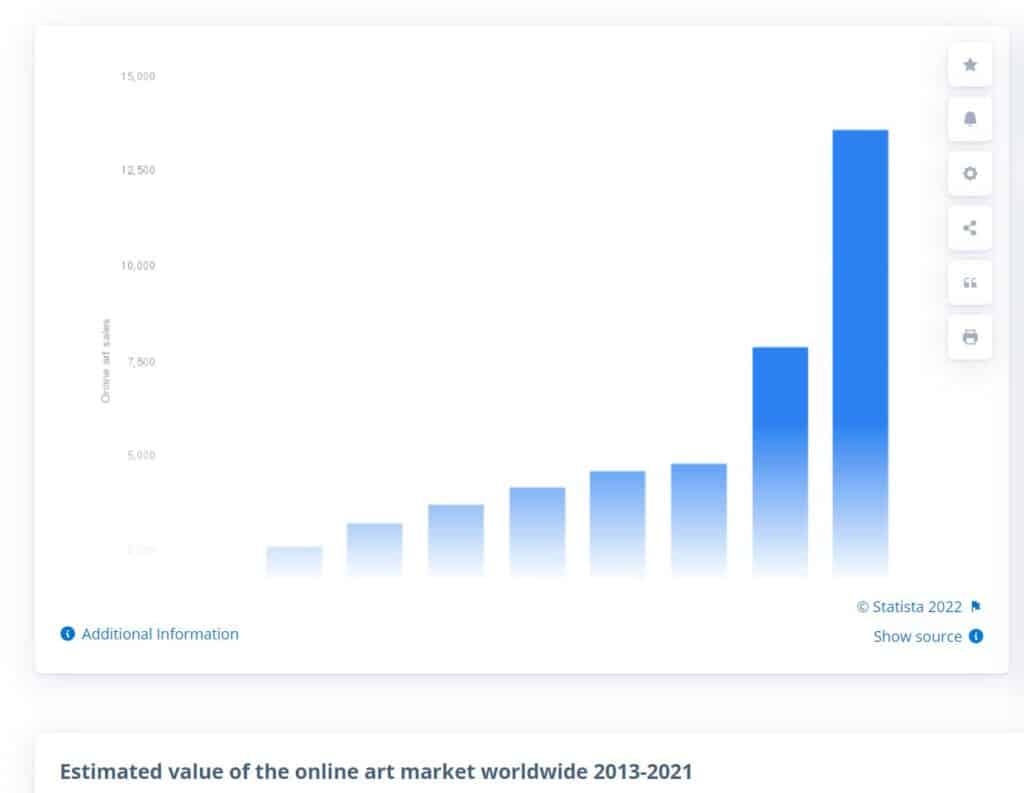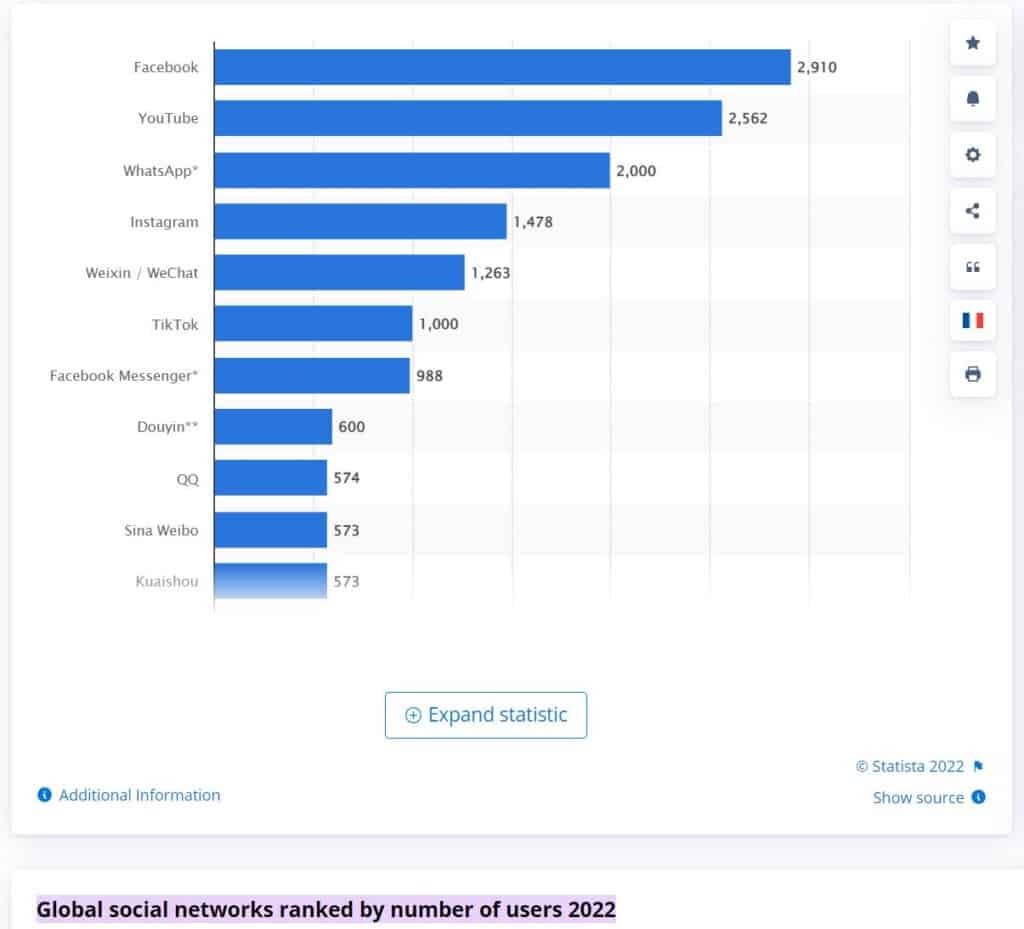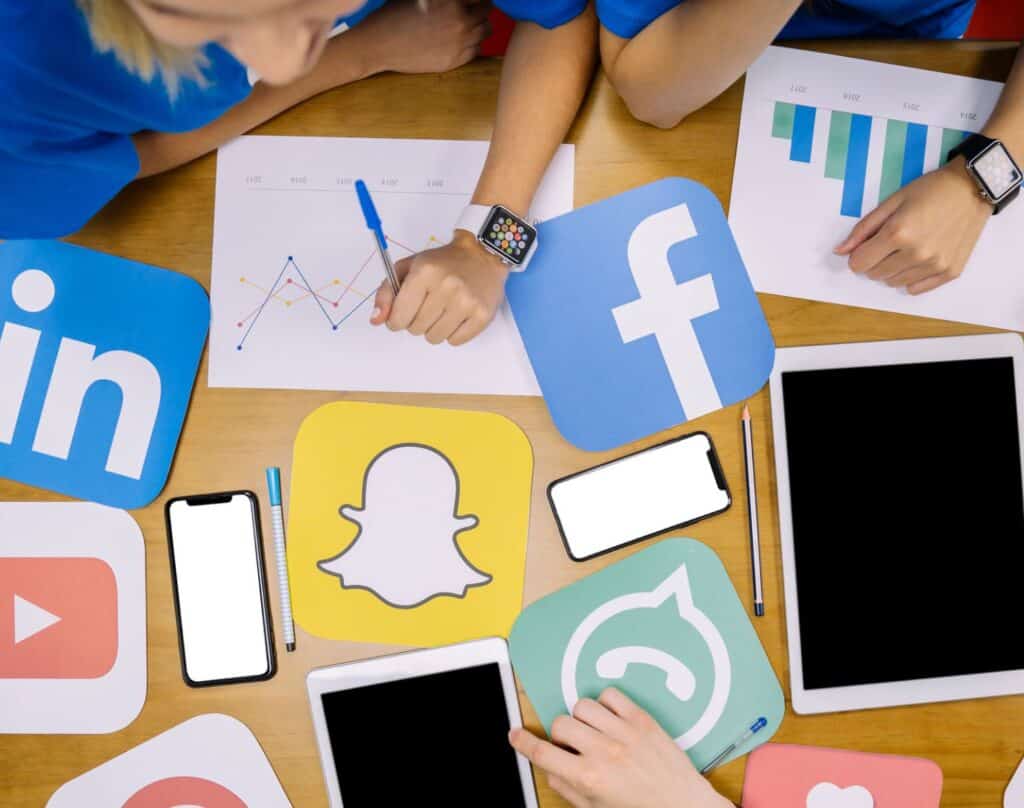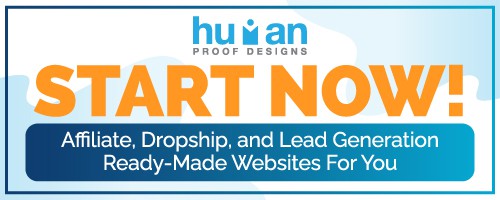If there's anything that social media is great at, it's establishing relationships and sharing imagery. Think about the people you've met or reconnected with on your platforms and the types of content you share. The latter is most likely comprised of visually stimulating images that evoke emotion.
This makes image-driven social platforms like Instagram and Pinterest ideal for showcasing visual arts. But, they're not the only online spaces that will help an artist gain a following and generate sales.
The Online Art Marketplace
Although art is subjective, it's a medium influenced by emotion. Marketing art on social media helps you to connect with your audience in a meaningful way. All it takes is a compelling story and high-quality images strategically posted in the right places.
Social media also has reached.
Consider that more than 4.62 billion people regularly use social media. They may not all be art collectors, but exposure to new genres, works, and artists levels the playing field for those who would like to invest in a few quality pieces but feel intimidated by galleries and the trappings of the traditional art scene.
The numbers bear this out.
Over the past two years, online art sales have nearly doubled to $13.6 billion, up from just $7.9 billion in 2020. Globally, art generates about $65 billion US dollars from online sales.

As for marketing art online, social media is more about sharing information and connecting with people than direct sales. These platforms are best used for driving traffic to your website and selling artwork to people without directly advertising anything.
How many loyal fans and followers will you gain when your work isn't restricted by geography? You just need to know how and where to showcase your talents.
Social Media Platforms That are Ideal for Selling Art Online
Not all social media platforms are created equally. Some are best for dispensing news or creating communities, while others entertain their audience with music and/or imagery.
Of the most popular social media sites, five or so are ideal for marketing your artwork online. You just have to know how to leverage their good qualities and neutralize the disadvantages.

YouTube
YouTube is more than just a video viewing platform. It's also the second largest search engine next to Google, owned by the same company. SEO and other ranking factors are just as important when creating videos for your art as creating content for your blog or portfolio site.
You can double-dip SEO by posting a clickable thumbnail for your YouTube channel on your website and in email marketing. Add alt tags for all video content so search engines can make better sense of it for indexing.
Pros:
- It's free to use
- You can increase your income through the YouTube Partners program and affiliate marketing
- Second largest search engine on the internet
- Many creator tools available to optimize your content
Cons:
- It can be a lot of work
- Steep learning curve if you don't know how to create/edit professional quality videos
- It's difficult to get much traction until you build an audience
Facebook is the largest social media platform, and more than 2.9 billion individuals have actively used it each month. However, it's better for community building than for straight advertising unless you want to pay for targeted ads.
Leverage this platform by creating a business page for your artwork and joining other groups and communities in a related niche. For example, if your work features animals, join groups populated by animal lovers. If your paintings or photography features airplanes or autos, join groups of aviation and car enthusiasts.
Don't try to sell other users on your work. Build a following by becoming active in these communities and establishing your authority in a friendly, engaging manner. Invite participants to follow your page and drive traffic to your website from there.
Pros:
- Large audience of users; the average Facebook profile connects with 130 other friends.
- Free to join
- User-friendly
- Great way to get immediate feedback
Cons:
- Works best with paid ads
- Posts can get lost in the clutter
- High distraction potential; you need discipline if you're using it solely for business
- Easy to get banned if your content is considered offensive or controversial
This social platform has become renowned for its influencer marketing potential as per the CEO of HowSociable. Like Facebook, it's owned by META. It's great for promoting visual media like images and videos.
But, you have to take a different approach than you would use when advertising on its sister site. With IG, it's all a numbers game.
Traffic is generated on this site by following other accounts and getting noticed by their followers. This is done by following each of them in turn. People will then check you out when they notice your interest in their content.
You will not generate direct sales on IG, but you can gain influence and reach by following accounts in a related niche. It takes time and determination but it will pay off if you're consistent.
Pros:
- Great for generating buzz
- Can be used with affiliate marketing
Cons:
- Only able to post one link in bios
- Takes time to build a following
- Censorship potential is high
Twitter works best for generating buzz on current and future events. There are approximately 6,000 tweets posted every hour, so you must build a following and post information that gets the user's attention fast.
Due to the amount of information and attention span of the average Twitter user, you should use an automation tool to tweet individual images of art for sale once an hour.
Yes, it's that labor-intensive.
You should also follow other accounts in your niche and the art world and often engage to turn interested your way.
Pros:
- Easy to use relevant hashtags to gain interest
- Good for news releases
- Lots of tools available to leverage the tech
Cons:
- Fast-paced and labor-intensive
- Difficult to cut through the clutter
Pinterest is a search engine disguised as an image-posting platform. The trick to marketing this site is to optimize it specifically for your audience. That means creating themed pages and using strategic SEO to drive the right traffic to your pins.
The search engine will get the traffic to your page, but you have to do the work of engaging with other Pinterest users in your niche. When the algorithm notices that other users are interested in your content, they'll send more people your way.
Start by creating the main page entitled “Art for Sale” and populating it with high-quality images of all of your work. Then, create 5 or 6 sub-pages that are themed by type or topic.
Pros:
- Creativity is a bonus
- Built-in search engine
- High referral rate
- Great visual showcase
Cons:
- Problems with copyright infringement and intellectual property theft
- Can be repetitive
- Unrealistic expectations generated by the platform in terms of potential art sales
Other Social Platforms
Platforms like Reddit and Quora aren't normally included in discussions on social media marketing. However, sites like these are great for networking and establishing authority in your niche.
For example, you can join art-related forums and discussion groups on both forums. This will allow you to keep up with industry trends and forge important relationships with other artists and collectors.
Although you wouldn't generally post images of your work, and some threads frown on blatant advertising, you can steer participants to your online gallery.
You can also pay for ads on Reddit. Answering art-related questions on Quora helps establish authority and trust. You could become the go-to expert in your niche.
Follow platform guidelines and individual rules for Reddit communities called sub-Reddits.
In addition to social media platforms, there are several socially oriented eCommerce sites that were specifically created to showcase artists and their works. These spaces are more like portfolio websites than traditional sites for social interaction.
They also don't have the kind of traffic you'll find on Facebook or IG. However, they offer the benefit of access to a qualified pool of potential buyers who frequent these platforms because they're art lovers and investors.

Presenting Your Art for Sale on Social Media
Social media isn't for generating sales, per se. That's what your website or online gallery will do. It's for gaining exposure, building a community, and generating buzz for your work. When you do it right, the sales will come on their own.
Social media marketing artwork means more than just posting an image of your latest collection with a purchase price or a link in the description. Remember, you're building relationships rather than selling products. Sales will come with exposure and engagement.
First, make sure to fill out your profile bios with all your contact information and links to your website. Use SEO and keywords/phrases strategically on titles, descriptions, and in your bio to make your content visible on social media.
Gain visibility and authority by adding value to your audience.
How do you add value to an image of a painting or sculpture? By not just posting images of finished works.
For example, you could post a video on YouTube of a work in progress. Hold a contest on Facebook to name your collection. Offer a signed print as a prize. Create a how-to video on art preservation.
Before you create a profile on any social media platform, know why you're doing it. What do you hope to accomplish? Who is your audience, and how do they interact on their platform?
You should also be consistent with your content. Create a posting schedule so followers know when to expect new content and stick to it.
If social media outreach cuts your time, consider hiring a social media manager to handle that aspect of your marketing. However, it's still important that you engage with your audience personally rather than leaving it up to someone else.
Before using a hashtag or hopping on a trend, ensure that you understand what you're posting and that it's relevant to your work.
Final Thoughts About Selling Art on Social Media
Marketing and selling art on social media provides many opportunities to grow your audience and build a loyal following. Best of all, there's very little investment other than time.
We're here to help build your online brand so that you can focus on what you do best: creating amazing art.
This article was written by Uday Tank, who is an astute business enthusiast with more than eight years of experience helping businesses reach their full potential. He is the founder and CEO at Rankwisely, providing invaluable support & services for businesses to leverage SEO, content marketing, keyword research, and Link Building to 25x their marketing ROI





